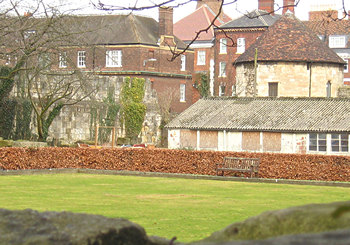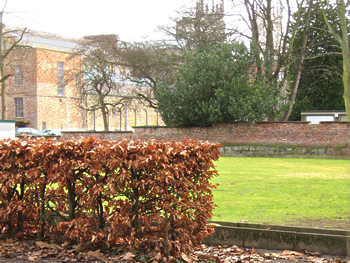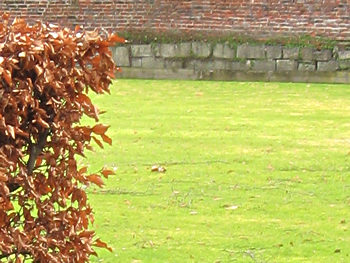February 2011

Back in June 1644, during the siege of York, this was the site of a major explosion, collapsing stonework, and a frantic battle across bowling greens and orchards. In 2011, there were plans to site a massive observation wheel here – since abandoned.
Many men died here, after the only successful attempt to breach the city’s defences. St Mary’s Tower (visible at the back, with its conical roof) was partially destroyed in the attack. The besiegers entered, and as a contemporary observer on the Royalist side reports: ‘above forty of the Enemy were slain in the Garden and Bowling green’.

Sir Henry Slingsby (1602-1658) – a member of the Royalist garrison defending the city – also recorded the battle on the bowling greens in his diary:
Manchester, who had his Quarters about Clifton & Huworth … makes his approaches, works his mines under St. Mary’s tower without Botham barr, & rais’d a battery against ye manner Wall that led to ye orchard-, he begins to play wth his Cannon & throws down peice of ye Wall. We fall to work & make it up with earth & sods; this happn’d in ye morning: at noon they spring ye mine under St. Mary’s tower, & blows up one part of it, which falling outwards made ye access more easy; Then some at ye breach, some wth Ladders, getts up & enters, near 500.
Sr. Philip Biron ye had ye guard at ye place … was unfortunately kill’d as he open’d ye doors into ye bowling green whither ye enemy was gotten…
So, in 1644 there was a bowling green in this area, and, more suprisingly, it had ‘doors’.
Sir Philip Byron (‘Biron’), mentioned above, is buried in York Minster, as is Major Richard Huddleston, who also died in the attack. Several parish churches, including St Olaves, just nearby, record burials of soldiers on the days following. Hildyard’s account gives special mention to ‘Samuel Breary … Lieutenant Colonel of a Company of 250 stout Volunteer Citizens, being shot with a poysoned Bullet into one of his Arms, four days after dyed.’

This particular bowling green, pictured in 2011, has been on the site for around a hundred years, apparently on land which was once part of the orchards mentioned above, and pasture within the abbey walls. The 17th century bowling green was a little closer to the King’s Manor buildings. As there were hundreds of men fighting here, the distinction isn’t really important, they would have covered the area between King’s Manor and St Mary’s Tower.
The bowling green will be lost soon, as there are plans to landscape the area as an extension of the Museum Gardens.
A reminder of a more recent conflict, alongside the bowling green – the hutments, built during the Second World War (since demolished).




